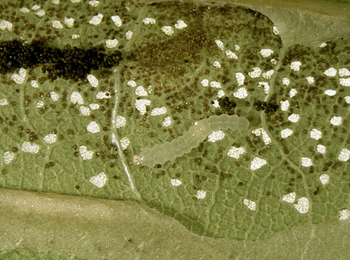|
||||||
|
Phyllonorycter
platani (Staudinger, 1870) London Midget Lithocolletis
platani
Staudinger, 1870. Horae Soc. ent.
Ross. 7: 277, t. 3 fig. 18. |
|||||||||||||||||||||||||||||||||||||||||||||||||||||||||||||||||||
|
Leaf-miner: Large mines, often several larvae in one leaf. Generally underside between veins. The upper side becomes mottled. On upper side can be over veins (British leafminers). The mine begins as an epidermal corridor, sometimes several cm in length. This widens into a shallow, greyish green, irregularly lobed blotch. The fully developed mine is an orange brown tentiform mine with a number of length folds. Almost all mines are lower-surface. The upperside of the mine then is a mottled oval, because the larva here and threre has eaten holes in the roof of the mine, i.e., the palissade parenchhyma (Bladmineerders van Europa). The mine is also illustrated in UKMoths. Larva: The larvae of moths have a head capsule and chewing mouthparts with opposable mandibles (see video of a gracillarid larva feeding), six thoracic legs and abdominal legs (see examples). The larva is colourless and transparant. Note also the two types of frass: small, light brown granules scattered throughout the mine, and larger blackish brown grains in an elongate clump. The light spots (see below) are windows the larva has eaten in the palissade parenchyma, the roof of the mine (Bladmineerders van Europa).
Pupa: The pupae of moths have visible head appendages, wings and legs which lie in sheaths (see examples). Pupation inside a white cocoon (British leafminers). The pupa is also illustrated in Bladmineerders van Europa. Adult: The adult is illustrated in UKMoths.The species is included in mothdissection.co.uk. Hosts in Great Britain and Ireland:
Hosts elsewhere:
Time of year - larvae: July - November (British leafminers). The mines formed in October and November are large and very distinctive, with several mines often appearing on one leaf (UKMoths). Time of year - adults: The moths fly in late April to May and in August (UKMoths). Distribution in Great Britain and Ireland: Since its discovery in London in 1989, this species has slowly spread through the southern counties of the UK and into the West Country and Midlands (UKMoths) including Bedfordshire, East Norfolk, East Suffolk, Glamorgan, Hertfordshire, Huntingdonshire, Leicestershire, Middlesex, North Somerset, Shropshire, West Gloucestershire, West Norfolk and West Suffolk (NBN Atlas). See also British leafminers distribution map. Distribution elsewhere: Widespread in continental Europe including Austria, Belgium, Bulgaria, Corsica, Cyprus, Czech Republic, Danish mainland, Dodecanese Is., French mainland, Germany, Greek mainland, Hungary, Italian mainland, Liechtenstein, Macedonia, Madeira, North Aegean Is., Poland, Portuguese mainland, Romania, Sardinia, Sicily, Slovakia, Spanish mainland, Sweden, Switzerland, The Netherlands, Ukraine and Yugoslavia. Also recorded in Near East (Fauna Europaea). NBN Atlas links to known host species:
British and Irish Parasitoids in Britain and elsewhere: |
|||||||||||||||||||||||||||||||||||||||||||||||||||||||||||||||||||
| Last updated 11-Jul-2019 Brian Pitkin | ||

